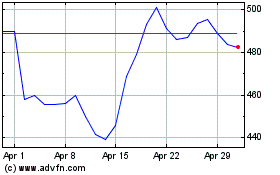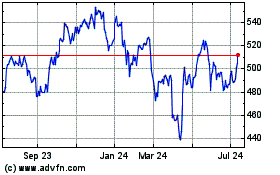The Four Companies That Sent the Dow to 19000
November 23 2016 - 8:02AM
Dow Jones News
Shares of banks, industrials and health-care companies propelled
the Dow Jones Industrial Average to 19000 on Tuesday. The bets on
those sectors largely reflect investors' expectations of looser
regulation, and higher growth and interest rates under a Trump
administration. Here is a look at four companies that have
benefited from those assumptions, contributing the most points to
the blue-chip index's 1,135.59-point gain since the Dow last closed
below 18000 on Nov. 4.
Goldman Sachs Group Inc. (contributed 240.99 points to the Dow
industrials since Nov. 4) and J.P. Morgan Chase & Co. (73.76
points)
The two banks have been big factors in the blue-chip index's
rally this month, largely because of the improved outlook for bank
earnings and the rebound in long-term bond yields, which can make
lending activity more profitable.
That has particularly helped J.P. Morgan, the largest bank in
the nation by both assets and market value. Since the presidential
election, bond yields have risen and the gap between long- and
short-dated debt has widened. That should help banks' income
because it increases the difference between what lenders charge on
loans and pay out on deposits.
President-elect Donald Trump has also made comments about
infrastructure projects to boost the economy. Banks and Wall Street
firms such as Goldman Sachs are likely to be in the middle of these
plans, either as advisers or lenders. Goldman, which derives more
of its revenue from advising companies and trading their
securities, also stands to benefit from increased volatility in
recent weeks and widespread debate about the future of the global
economy. Both factors increase investors' appetite to trade, which
helps the firms' massive bond and stock-trading desks. Investors
are also betting on reduced regulatory and tax costs under a Trump
administration, which should help banks. Many of the prospective
appointees for key economic posts in a Trump administration either
have worked on Wall Street or have expressed sympathy with the idea
that banks have been too heavily regulated.
Analysts at Credit Suisse expect earnings per share in 2017
could beat their pre-election base case forecast by 24% at Goldman
and 30% at J.P. Morgan. However, it is an improvement from low
expectations and conditions are still far from ideal for the big
U.S. banks. For example, while there have been recent signs of
health -- notably increased trading volumes -- long-term interest
rates are still lower than they were a year ago and the so-called
yield curve is slightly flatter -- which means interest income will
likely remain under pressure.
--John Carney
UnitedHealth Group Inc. (99.64 points)
The largest U.S. health insurer has struggled to eke out
profitability from its Affordable Care Act plans. UnitedHealth
Group has said it intends to withdraw from nearly all of the
health-law marketplaces next year amid anticipated annual losses of
about $850 million on ACA plans. Other insurers have also pulled
back from their coverage areas under the law, leaving many counties
with only one participating insurer and increased premiums.
President-elect Donald Trump has pledged to "repeal and replace"
the Affordable Care Act. Still, the law has also resulted in a
Medicaid expansion, bringing new customers to the insurer. In its
latest quarter, the company added 9% more Medicaid members.
UnitedHealth also said medical spending was in line with its
expectations, reassuring investors. The company has increasingly
relied on its health-services unit, Optum, to drive growth. Optum
is rapidly expanding its primary-care business and the unit, which
also has analytics and pharmacy services divisions, is a
differentiator for UnitedHealth compared with other insurers. In
its latest quarter, revenue grew 12% to $46.29 billion.
--Austen Hufford
Caterpillar Inc. (77.45 points)
The manufacturing giant has faced a tougher second half of the
year than executives were expecting amid persistent weak demand for
its construction, mining and oil equipment around the world.
Revenue fell 16% in its latest quarter, and the company in October
predicted another tough year in 2017 as the company deals with the
fallout from the global commodities bust and prepares for a
transition in top leadership. Caterpillar, whose sales hit an
all-time high in 2012 under Chairman and Chief Executive Doug
Oberhelman, has struggled since his move to drive the company
deeper into mining equipment by pouring billions of dollars into
factories. The move backfired when miners began shelving
equipment-buying plans as commodity prices fell. Mr. Oberhelman
will retire next year, earlier than expected, leaving company
veteran Jim Umpleby to battle a historic sales slump after
ill-timed bets on China and mining equipment.
--Joshua Jamerson
(END) Dow Jones Newswires
November 23, 2016 07:47 ET (12:47 GMT)
Copyright (c) 2016 Dow Jones & Company, Inc.
UnitedHealth (NYSE:UNH)
Historical Stock Chart
From Mar 2024 to Apr 2024

UnitedHealth (NYSE:UNH)
Historical Stock Chart
From Apr 2023 to Apr 2024
